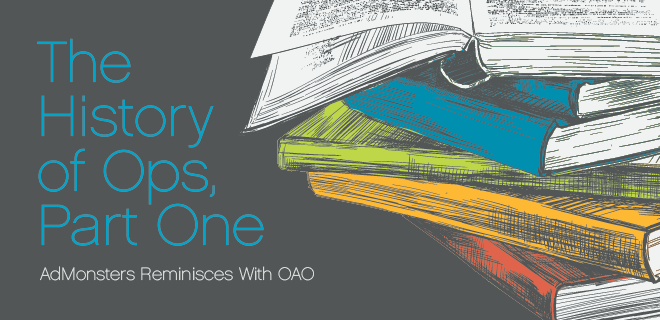
“This industry is literally 20 years old,” comments Michael Alania, EVP at Outsourced Ad Ops and witness to the at-times insanely rapid evolution of digital advertising and the operations role at its core. “You look at where we are now versus where we’ve come from, it’s pretty staggering. And with how quickly technology is developing and evolving, you have to wonder where we’ll be in another 20 years.”
It’s something to ruminate on, and fortunately I am in a room full of ruminators – Alania, OAO Founder and President Craig Leshen, who began his career in ops back in 1996 at Hachette Filipacchi Magazines, and AdMonsters Content Czar Rob Beeler, who gained his ops laurels while deep in the Advance Internet (now Advance Digital) stack. Over coffee and pastries, they are taking a trip back to the days before third-party ad servers, and when hacking was standard operating procedure. I’ve been allowed to sit in and take notes, occasionally nagging for more details about the distant past – which just so happens to have taken place in the blink of an eye.
This excursion through time is not only to reminisce, but also to examine how the 2001 Internet bubble burst shaped contemporary ad operations (http://adops.com/the-job-of-ad-ops/) and heralded its rise within the digital media ranks. However, as we talk it becomes obvious that many issues have lingered throughout the years, and the more the industry changes, the more it stays the same.
We kick off by marveling at a new app pushing the limits of ad serving technology, and juxtapose that with working with the constantly evolving world of ad creative. So I ask, “how do ad ops people quickly adapt to an ever changing industry and work within the limitations of technology struggling to keep up with advertiser demands?”
CRAIG LESHEN: It’s not so much that the technology is limited. However, the growing complexity of this industry combined with the infinite potential sources for creative innovation, makes it tough for any technology to keep up. Consider all the types of rich media out there and the number of devices you have to test on. It’s not like trafficking various types of rich media takes a lot of time – it used to. But now you might have an integrated sponsorship that hits display, mobile, video, connected TVs, Xbox, Roku – everything is tied together and you have to test it against all these devices. Sometimes it’s not the rich media which is complicated, but the campaign itself. It’s a lot of hands-on ops work.
MICHAEL ALANIA: It also goes beyond just the devices – it’s all the vendors that you’re working with too, like the agency-side ad servers, the tracking pixels, the surveys… The complexity does not go away as the ad ops function evolves; on the contrary, it becomes more prevalent. It’s not only dealing with the multiple platforms, various integrated technologies, and advanced campaign executions, but also doing it at scale.
ROB BEELER: See, ops is like an API – the glue that connects it all together. Sometimes it’s rubber bands and sometimes it’s actually pretty cool. That’s the part that’s different from the old days when it was a hack. You were inventing solutions every time. Now the pieces have been invented, but you still have to know how to connect them together…and sometimes invent new solutions too.
MA: I like the idea of ops as an API because it connects a lot of different points within the ecosystem. That was the mindset in the past and it’s still somewhat relevant today – “Well, if no one else can do it, it must be an ad ops function.” It’s not really IT, it’s not really sales, it’s not really development – it’s gotta be ad ops.
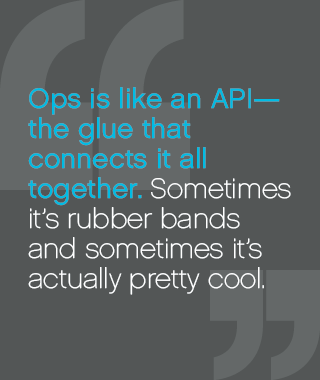
Where Did This Ops Wizard Come From?
MA: In my experience, ad ops evolved out of opportunity. We [as an industry] could run ads – so let’s get somebody who can actually understand tech, can communicate clearly, is organized and can interface with internal and external groups.
My first job in 1996 was “online production supervisor” – it was very generic. Even when I went to Modem Media later that same year, they also didn’t have a name for what eventually became known as ad ops. I was a media analyst. No one knew what ad operations was. They knew there was a group that lived in the media department that worked with media buyers and planners. This group would gather the assets from the production team, organize the info, and email all the details to each website where the ads were supposed to run. The role evolved and transformed from there as the technology started catching up.
The Birth of Process
RB: The maturation of ad ops was when we were able to put process in place. In other words, early days, you’d start your day and you weren’t sure what was coming. But once you got enough control over your job, you could say, “All the standard JPEGs go this way, all the Flash goes that way,” and when you want to add something like CSS to an ad for the first time, you go down a different path.
CL: Exactly. It’s a very different kind of world today. It’s gone from, “Let’s just get it done,” to, “Wait a sec – there’s a lot of stuff we have to factor in.” There’s a whole lot of new tech, cross-device, cross-platform, … cross-everything. It’s the difference between building the Model T and the Tesla.
MA: There’s evolution of tech and evolution of workflow. Fourteen years ago, there wasn’t workflow; it was triage, like you were in a MASH unit. Companies eventually put in processes because they understood how valuable ad ops is to revenue recognition. They tied it in with finance, with sales, with overall strategy. Now ops has a seat at the table in forward-thinking companies, and that’s a watershed moment in the evolution of ad ops. It’s now viewed as strategic to the business.
The Best Salespeople Worked With Ops
RB: There was a need to sell, and you would sell these ideas, and you knew there was an ops person to figure it out. Every once in a while, an ops person would stomp their feet and get upset, have a hissy fit or whatever, but at the end of the day they delivered more often than they didn’t. That was a sign of a good ops person – they just made it work.
CL: It was interesting back then. Stop me if this sounds familiar… A salesperson would sell a custom campaign that needed to go live ASAP. The ops person’s response would be, “You just sold something that doesn’t exist.” Which was then typically followed by, “…but let’s figure out how to get this done.” With ops, it’s never “you can’t fit a square peg into a round hole.” Ops says, “give us a square peg and some sandpaper, and we’ll make it happen.”
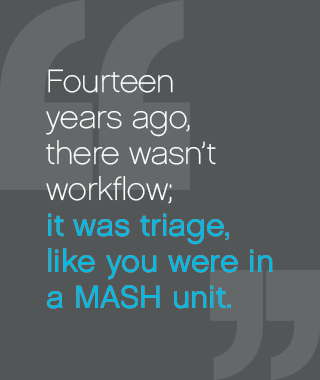
MA: It wasn’t as simple as, “Let’s just sell it, get the $100,000 buy booked and let accounting deal with it.” It was more like, “We need to stand out from the rest of the publishers so let’s try to come up with something special and make sure ad ops can deliver it.” At the end of the day, you can sell as much as you want, but if it doesn’t deliver, there’s no revenue (and no commission). The best salespeople were the ones who understood that and worked with the ad ops team to make sure everyone was on the same page so each campaign would run smoothly.
When Ops Got a Voice
RB: When ops started being listened to was when the Internet bubble burst. I always heard, “You can no longer throw salespeople at a revenue problem.” You can’t hire armies of people and think you can sell your way out of a hole. Suddenly the attention went to efficiency and operations. All the eyes started turning to that lone guy in the corner.
MA: It was the lone ad ops guy who would say, “All right, I’ll take care of it.” That’s indicative of a skillset that evolved with ad ops. An ad ops person is not a tech guy writing code; you’re not a sales guy going out on business calls; you’re not a web programmer swimming in HTML; you’re everything. You’re a troubleshooter, a problem-solver; you’re a face-to-face person; you can talk internally, you can manage up, down or outwardly; and you understand technology.
The Rise Of CPC and CPA
CL: Back in 1999, Mike and I were at Phase2Media – we saw everything fast-forwarding:
Offline deals (i.e. magazine and tv) that had an online, value-add, components began to disappear, and salespeople were selling online directly. Phase2Media became a big business very quickly – about 250 people at one point before our industry’s bubble burst. CPMs were dropping rapidly, and that’s when we saw the rise of CPC and CPA advertising.
MA: Advertisers were still trying to figure out if it was a viable medium. They said, “Look, we’re only a few years into this. We want to run ads, but we don’t want to have risk. So we’re willing to displace our risk onto you, Mr. Publisher; if you’re able to sell our product on your site, you’ll get paid for it.” That’s when CPC and CPA had some value because people weren’t banner-blind yet; they actually clicked when they wanted to. Our industry definitely went through a rough patch between 2001 and 2003
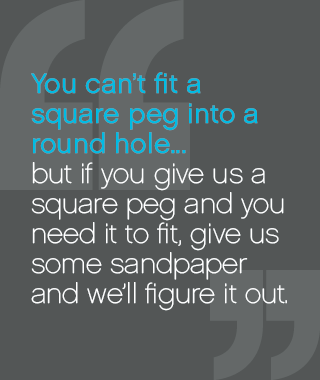
RB: The Dark Ages – at the time I turned toward operations, we were starting to let people go. If you were both a tech and a business person, you started to understand how operations was going to play out. That was the beginning of ops being a function. I remember hearing, “Let go of two people, and by the way, we need you to do more.” I couldn’t get away with just hacking anymore; I had to be efficient.
CL: In 2003, companies woke up and realized, “We need to make some changes here, ‘cause if we don’t, this whole thing is going to collapse. Rates are plummeting, and big advertisers are spending next to nothing and still getting all this coverage.” That’s when they hit the whole thing with a wrecking ball and said, “What are we going to do to build this back up again?” The first step was to re-think your structure. Use the building example: With a building you must have a solid foundation. You have to lay the concrete, put the pipes in, run your wires and cables, and install the windows before you bring the tenants in.
The Outsourcing Opportunity
RB: When OAO started in 2003, operations must have been at a certain point of development for you to see the business opportunity of outsourcing.
CL: Revenue was shifting, the bubble had burst, the stock market had tanked, and funding was tougher to come by – media companies knew they needed to build that solid foundation. Ad ops was getting more complicated; you could no longer be the guy who just took an image and put it on a page. We were working 10-15 hour days, because everything was falling downhill and we were catching all of it. So much more was required of ops, and you needed to be much smarter because tech was improving – you had to understand HTML, Javascript, different types of ad creative, etc.
You needed some kind of outside firm you could go to, because it wasn’t like ad ops budgets were increasing while ad revenue was in flux. Companies still wanted to pay the same amount, but needed knowledge and expertise. They didn’t necessarily want to off-shore; they wanted local, hands-on services and support. There was definitely a space for OAO, the opportunity was there, and I wanted to build.
The Call of the Network
RB: Remnant and networks created a shift within ops. At Advance, we didn’t accept networks at first, then occasionally did deals. Essentially ops became the top revenue source and the conversation changed. That was 2004-2005, because once Google AdWords rolled out, you got a guaranteed check each month.
Strategically, we let the fox into the henhouse, but it was still a power shift and changed who owned the relationships. Managing networks was typically an operations function because you didn’t want to put a salesperson’s commission on top of that. It changed my view of the business when I realized how networks’ capabilities compared to mine as a publisher – they could sell my site in ways I couldn’t. I started plotting – it’s funny to say I wanted to be as good as a network.
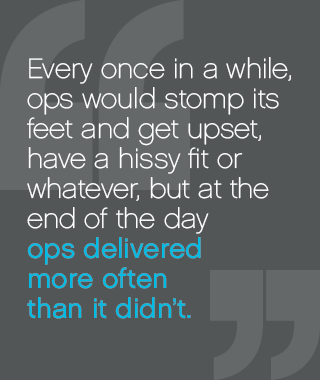
CL: You had a lot of companies that were turning the networks away. Companies would ask, “Do we want to run that one remnant company because advertisers will have access to buying the site at lower rates?” You would plug in one or two remnant deals and everybody would get nervous, but sometimes your sales team would get stronger because the networks pushed them, because the ease of access to their inventory pushed them. A salesperson couldn’t go out and sell a $1 CPM anymore; they needed to perform better than the networks.
You also started seeing significant reporting variances start to come up more often. Back then you didn’t have the worry of the fourth or fifth-party calls, but advertisers were buying via remnant networks, and publisher delivery variance was being measured against the network while the network was being measured against the advertiser’s tag. Remnant networks were only paying based on the revenue they were earning, and if the effective CPM of a remnant network fell, they would get less inventory from the publisher. That’s when the list of remnant networks started to grow.
Behavior Enters the Mix
RB: What about the rise of behavioral targeting? Then it became about more than just serving the ad and you started to add some of these contemporary elements.
MA: I remember working with Tacoda and AudienceScience. I remember hearing that they’re collecting all this information and “we can target our users with it.” We brought in their guy and he walked through how they create segments. “Well, if you go to these three pages, we’re going to classify you as an auto enthusiast and we’re going to target those ads to you.” OK, seemed simple enough. Fast forward to today and suddenly we can get offline information, email information, your habits online and tie them to a unique ID that can be segmented and targeted.
RB: When Tacoda came out, I told my bosses, I’m already doing this. I can set a cookie for anyone who goes in the auto section. I just can’t work it. If you gave me enough hardware, I could. Back then, it was like, “You want to buy a what-size server?” As the processing capabilities grew, it offered us so much more ability.
MA: That was a big deal at the time and only a few clients were doing it. Behavioral caught on and then DoubleClick introduced Boomerang. After that the question started shifting to, “Why are we only targeting our users while they’re on our site? Why don’t we use our data and find our users when they’re on other sites?” That was pretty mind-blowing at the time.
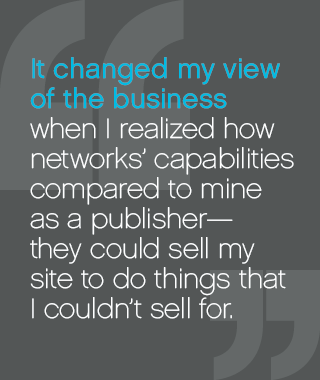 Pop Up, Pop Under
Pop Up, Pop Under
RB: When the standards came out and we moved from banners to leaderboards, I remember editorial saying, “That size is too big and we’re not going to ever take these.” It was a real battle, but eventually you just waited to see the number of deals that came through.
CL: Do you remember the first time you heard a banner referred to as a leaderboard? Names for creative sizes? (Laughter) First we had the 234X60, which then became the 468X60, which eventually became the 728X90 we all know and love today.
RB: Then, of course, the pop-under.
MA: It was a pop-up first, then a pop-under.
CL: Ops people are actually the reason why it pops under and not over. We figured out that was less intrusive and it was technologically possible.
MA: In 2005, when pop-ups were really big, people would say, “Oh, you make these awful ads pop up on my computer?” To which I would reply, “Well, I make web content free for you. Because advertising supports your ability to go online and see everything you want at no cost.” “Oh, interesting… I still hate the ads.” “Well, I guess you can’t have everything.”
In 1998, I was working at Modem Media. People would ask what I did for a living, and I would say that I’m a producer at an online ad agency. “What do you produce?” “I produce websites and ads that run on websites.” It was hard for them to comprehend the process and skill set needed to create and develop what they saw in Netscape. “What do you mean you do this? It just appears!” Then they would say, “This internet thing is kind of a fad; make sure you have something to fall back on.” In 2014, this is where everyone wants to be.
Stay tuned for the next chapter in our saga…
